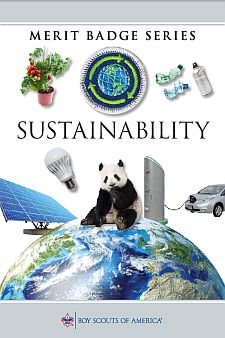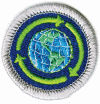Either this Merit Badge or Environmental Science MB
is required to earn the Eagle Scout Rank
- Before starting work on any other requirements for this merit badge, write in your own words the meaning of sustainability. Explain how you think conservation and stewardship of our natural resources relate to sustainability. Have a family meeting, and ask family members to write down what they think sustainability means. Be sure to take notes. You will need this information again for requirement 5.
- Do the following:
- Water. Do A AND either B OR C.
- Develop and implement a plan that attempts to reduce your family's water usage. As a family, discuss water usage. To aid in your discussion, if past water bills are available, you may choose to examine a few. As a family, choose three ways to help reduce water consumption. Implement those ideas for one month. share what you learn with your counselor, and tell how you think your plan affected your family's water usage.
- Using a diagram you have created, explain to your counselor how your household gets its clean water from a natural source and what happens with the water after you use it. Include water that goes down the kitchen, bathroom, and laundry drains, and any runoff from watering the yard or washing the car. Tell two ways to preserve your family's access to clean water in the future.
- Discuss with your counselor two areas in the world that have been affected by drought over the last three years. For each area, identify a water conservation practice (successful or unsuccessful) that has been used. Tell whether the practice was effective and why. Discuss what water conservation practice you would have tried and why.
- Food. Do A AND either B OR C.
- Develop and implement a plan that attempts to reduce your household food waste. Establish a baseline and then track and record your results for two weeks. Report your results to your family and counselor.
- Discuss with your counselor the ways individuals, families, and communities can create their own food sources (potted plants, family garden, rooftop garden, neighborhood or community garden). Tell how this plan might contribute to a more sustainable way of life if practiced globally.
- Discuss with your counselor factors that limit the availability of food and food production in different regions of the world. Tell three ways these factors influence the sustainability of worldwide food supplies.
- Community. Do A AND either B OR C.
- Draw a rough sketch depicting how you would design a sustainable community. Share your sketch with your counselor, and explain how the housing, work locations, shops, schools, and transportation systems affect energy, pollution, natural resources, and the economy of the community.
- With your parent's permission and your counselor's approval, interview a local architect, engineer, contractor, or building materials supplier. Find out the factors that are considered when using sustainable materials in renovating or building a home. Share what you learn with your counselor.
- Review a current housing needs assessment for your town, city, county, or state. Discuss with your counselor how birth and death rates affect sufficient housing, and how a lack of housing—or too much housing— can influence the sustainability of a local or global area.
- Energy. Do A AND either B OR C.
- Learn about the sustainability of different energy sources, including fossil fuels, solar, wind, nuclear, hydropower, and geothermal. Find out how the production and consumption of each of these energy sources affects the environment and what the term "carbon footprint" means. Discuss what you learn with your counselor, and explain how you think your family can reduce its carbon footprint.
- Develop and implement a plan that attempts to reduce the consumption for of one of your family's household utilities that consume energy, such as gas appliances, electricity, heating systems, or cooling systems. Examine your family's bills for that utility reflecting usage for three months (past or current). As a family, choose three ways to help reduce consumption and be a better steward of this resource. Implement those ideas for one month. Share what you learn with your counselor, and tell how your plan affected your family's usage.
- Evaluate your family's fuel and transportation usage. Review your family's transportation-related bills (gasoline, diesel, electric, public transportation, etc.) reflecting usage for three months (past or current). As a family, choose three ways to help reduce consumption and be a better steward of this resource. Implement those ideas for one month. Share what you learn with your counselor, and tell how your plan affected your family's transportation habits.
- Stuff. Do A AND either B OR C.
- Keep a log of the "stuff" your family purchases (excluding food items) for two weeks. In your log, categorize each purchase as an essential need (such as soap) or a desirable want (such as a DVD). Share what you learn with your counselor.
- Plan a project that involves the participation of your family to identify the "stuff" your family no longer needs. Complete your project by donating, repurposing, or recycling these items.
- Discuss with your counselor how having too much "stuff" affects you, your family, and your community. Include the following: the financial impact, time spent, maintenance, health, storage, and waste. Include in your discussion the practices that can be used to avoid accumulating too much "stuff."
- Water. Do A AND either B OR C.
- Do the following:
- Explain to your counselor how the planetary life-support systems (soil, climate, freshwater, atmospheric, nutrient, oceanic, ecosystems, and species) support life on Earth and interact with one another.
- Tell how the harvesting or production of raw materials (by extraction or recycling), along with distribution of the resulting products, consumption, and disposal/repurposing, influences current and future sustainability thinking and planning.
- Explore TWO of the following categories. Have a discussion with
your family about the two you select. In your discussion, include your
observations, and best and worst practices. Share what you learn with
your counselor.
- Plastic waste. Discuss the impact plastic waste has on the environment (land, water, air). Learn about the number system for plastic recyclables, and determine which plastics are more commonly recycled. Find out what the trash vortex is and how it was formed.
- Electronic waste. Choose three electronic devices in your household. Find out the average lifespan of each, what happens to these devices once they pass their useful life, and whether they can be recycled in whole or part. Discuss the impact of electronic waste on the environment.
- Food waste. Learn about the value of composting and how to start a compost pile. Start a compost pile appropriate for your living situation. Tell what can be done with the compost when it is ready for use.
- Species decline. Explain the term species (plant or animal) decline. Discuss the human activities that contribute to species decline, what can be done to help reverse the decline, and its impact on a sustainable environment.
- World population. Learn how the world's population affects the sustainability of Earth. Discuss three human activities that may contribute to putting Earth at risk, now and in the future.
- Climate change. Find a world map that shows the pattern of temperature change for a period of at least 100 years. Share this map with your counselor, and discuss three factors that scientists believe affect the global weather and temperature. Discuss with your counselor three impacts of climate change and how these changes could impact sustainability of food, water, or other resources.
- Do the following:
- After completing requirements 1 through 4, have a family meeting. Discuss what your family has learned about what it means to be a sustainable citizen. Talk about the behavioral changes and life choices your family can make to live more sustainably. Share what you learn with your counselor.
- Discuss with your counselor how living by the Scout Oath and Scout Law in your daily life helps promote sustainability and good stewardship.
- Learn about career opportunities in the sustainability field. Pick one and find out the education, training, and experience required. Discuss what you have learned with your counselor and explain why this career might interest you.
BSA Advancement ID#:
152
Requirements last updated in:
2020
Pamphlet Publication Number:
35711
Pamphlet Stock (SKU) Number:
654372
Pamphlet Revision Date:
2013
|
|||||||
Page updated on: November 18, 2021









